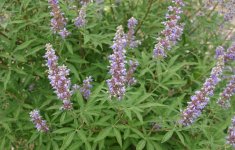Vitex sacred (Abraham tree) - vitex agnus-castus l.
Family Verbena - Verbenaceae
Botanical characteristics. Shrub or a small tree growing wild in the shores of reservoirs, mountain slopes, in river valleys in groups or small thickets. In culture, both ornamental and honey plant are grown.
Leaves are opposite palchatora-individual with 3-7 leaves, without stipules. Flowers with a five-membered perianth, passing into the tube. Calyx is fast-leafed, has a tubular shape with underdeveloped five prongs. Four stamens high above the corolla. The color of the corolla is soft blue. Flowers are collected in a dense inflorescence. Blossoms in May - June, fructifies in July - August. Fruit is a drupe, edible.
Used parts of the plant. Medicinal raw materials are leaves, flowers, fruits, branches, rarely bark. Raw materials are collected in the usual way: flowers during flowering, branches and leaves during the entire vegetation period of the plant, bark in spring or autumn, fruits - as they mature. Dry raw materials in air, fruits - in dryers at a temperature of no higher than 40 ° C.
Chemical composition. All parts of the plant contain iridoid: agnoside; Flavonoids: aukubin; Alkaloids, tannins, vitamins, microelements, essential oil.
The fruit contains fatty oil, organic acids in its composition: formic, acetic, propionic, oily, valerian, kapron.
Application. Fresh juice of a flowering plant is used in homeopathy, mainly with impotence, depression, nervous diseases, with the termination of breast-feeding infants.
Broth of branches and fruits - with gonorrhea; In Italy - as a contraceptive. Flowers in Central Asia and the Caucasus - with various skin diseases.
In the experiment tincture of the fetuses increases the function of the sexual glands. Infusion of flowers and leaves has a lactogenic effect and shows antibacterial activity.
In folk medicine decoction and infusion of fruits, leaves and bark have long been treated with liver diseases, spleen, infertility, mastopathy, fibroids in women, impotence in men, malaria.
Fruits are used as a spice, a substitute for pepper.
Preparation
- For infusion take 20 g of leaves and flowers, pour 200 ml of boiling water, insist on a water bath for 15 minutes, cool 45 minutes, without removing from the bath, filter. Take 1/3 cup 2-3 times daily before meals.
- For broth 15 g of crushed fruit or bark, pour 200 ml of boiling water, insist on a boiling water bath for 30 minutes, cool for 10 minutes, filter. Take 2 tbsp. Spoon 3-4 times daily before meals.
- To obtain tinctures from fruits or bark, take the crushed raw material, pour 70% alcohol at a rate of 1: 5, insist 15 days. Take 30-40 drops per reception, gradually increasing to 50-60 drops, before meals 2 times a day.




Comments
When commenting on, remember that the content and tone of your message can hurt the feelings of real people, show respect and tolerance to your interlocutors even if you do not share their opinion, your behavior in the conditions of freedom of expression and anonymity provided by the Internet, changes Not only virtual, but also the real world. All comments are hidden from the index, spam is controlled.